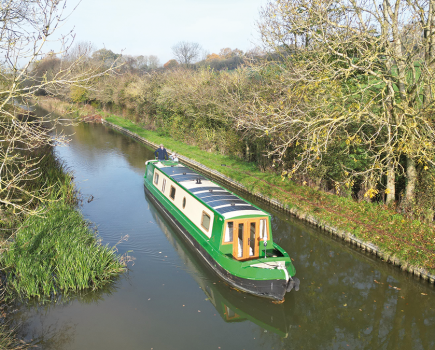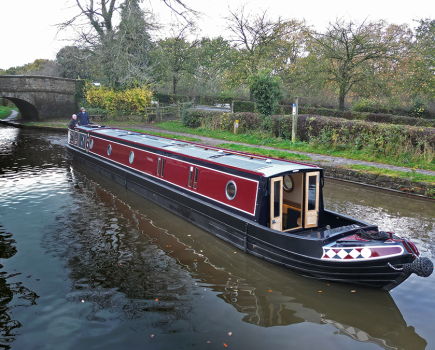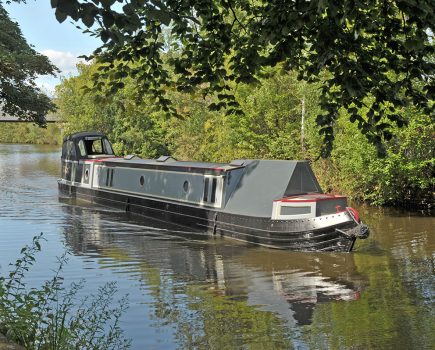Barry Hawkins Narrowboats 60ft
BARRY HAWKINS NARROWBOATS 60ftEnvy is supposed to be a sin but it is a very easy one to commit when you meet Ian and Allison Birks. Envy them for being able to retire at an age when most of us are still in regular nervous conversations with our bank manager. Envy them for choosing to spend the next ten years or more meandering with no particular place to go round the canal network. And envy them for being able to commission a Rolls-Royce among narrowboats to do it in.TUG OF LOVETheir boat, Nobby (named after the couple’s previous dog), is not just expensive but a very intelligently conceived mix of tradition and modernity and a beautifully crafted piece of work. Let’s dispatch the money thing first: it cost £145,000 – well if you have to ask, you can’t afford it, as they say.The boat was built by Barry Hawkins Narrowboats, one of those old-fashioned ‘proper’ boatbuilders who do the whole job from sheets of steel and planks of wood upwards.It is based on one of the company’s handsome Northwich tug replicas. The couple saw one at the Crick Show a few years back and were smitten. When choosing a boat for their travels, it was a shoe-in – with one amendment, the addition of a separate fore-cabin on the tug deck.The result is an absolute stunner of a boat full of carefully crafted details to admire: the towing horse harness rings, the rows of tiny balusters on which the roof grab rails are mounted, the break line in the cabin that defines the separation of engine room and what would have been sheeted cargo area but is now living space, the curved corners where cabin sides meet front, and the ‘rivetted’ hull – accurate to the extent that the replica rivets continue on in the underwater sections of the hull where you’ll only be able to admire every couple of years.And all this set off by a richly lustrous two-pack paint finish in wine red and cream, subtle enough to let the boat’s lines speak for themselves.DESIGN & LAYOUTNobby has been very carefully conceived to suit the couple’s long-term cruising lifestyle. When the boat was still a blank sheet of paper two items came top of the wish list – a Gardner 2L2 vintage engine for Ian and an Aga style cooker for Alison.Next most important consideration was stowage; lots of it. The result is a craft whose traditional exterior hides a surprisingly modern interior that comes with all mod cons.At the go-anywhere length of 60ft and with living space taken up by Ian’s Gardner engine room, a tug deck and a fore cabin, there’s been no room for the boatman’s cabin a traditionalist might expect to see.Instead the rear end is a utility cum storage area and the engine room has been moved back a tad to maximise living space. It leads on to a very modern, full width, walk-in wetroom, then comes the galley, with its Aga style Heritage stove mounted cross-wise in the centre of the boat, and finally the saloon.FRONT DECK
The high tug deck gives the boat quite a different feel to most ‘regular’ narrow-boats – you step onto it rather than into it.The fore-cabin, accessed via steel doors and hatch, is the boat’s garden shed, packed with all those things there’s never anywhere to put – hose, tools, spares etc. It’s as useful as any land-bound shed but can be tricky to clamber round or over if you find yourself needing to reach the front rope in a hurry.Nobby is a gas-free boat so the gas locker provides room for four 20 litre jerry cans of spare fuel. Again, the high deck line enables ample room for sizeable 150 gallon water and an 80 gallon secondary diesel tank for the cooker.SALOONIt’s a steep and sharp drop down the steps from the high deck into the saloon, which proves to be a surprisingly light and airy space despite the relatively small porthole windows and absence of any roof hatches. Using light materials throughout is the trick: the lining-out is in ash and the room’s two armchairs are cream leather.The saloon isn’t big – just 10ft 6in long – so it’s been kept spare and uncluttered. There are a pair of simple cupboards either side of the entrance steps. That on the port side has a flat screen TV on top with satellite decoder and DVD inside. The other cupboard is for general storage while a Bose hi-fi on top is there to play the couple’s 1,000 – yes one thousand – CDs that line the entire starboard wall of the saloon in strict alphabetical order(of course).All the joinery in the saloon (as in the rest of the boat) is done in ‘proper’ wood – solid ash rather than veneered ply or blockboard. The lining panels are located by substantial ash strips, with angled sides to reflect a little more light back into the room and the ceiling has matching ash ribs. A decorative cover hides the radiator.The saloon has a final trick up its sleeve. That high front deck has provided the space for a huge amount of built in storage underneath, accessible behind the steps (albeit on hands and knees) from the saloon. There are cupboards and drawers either side, and at the front a wardrobe runs right across the boat. Storage space is a valuable commodity on a narrowboat and this is a real asset.GALLEYThe light, bright feeling continues into the galley. A pair of side hatches (with clever and space-efficient sliding glass inner windows) lets plenty of daylight in and work surfaces in cream quartz stone reflect it around the room.The galley is dominated by the cream cast-iron Heritage stove (which was craned into position during the boat’s build). Though it looks like a traditional Aga, it is actually one of a new generation of more versatile cookers which have two separate burners th at can be separately programmed for cooking and heating.The couple run it via a programmer to supply all the boat’s domestic hot water and central heating, and turn on the cooker side when needed. Fuel consump-tion so far has averaged around five litres a day. (The hot water can also be heated electrically in summer when the cooker isn’t in use.) The galley units sit either side of a central aisle and, once more, are beautifully built in solid ash. As elsewhere, first class space efficiency was the requirement and no nook is without a shelf or cranny without a cupboard.The starboard side carries a compact Belfast style sink and a row of drawers and cupboards, and there’s even a shallow cutlery drawer in the forward edge of the units. Opposite, the fridge is concealed behind bi-fold doors and there are further cupboards and shallow shelves. Finishing touch to the stylish galley is the gleaming array of matching cooking utensils on the wall behind the cooker.CABINA doorway on the port side leads through from the galley to the cabin where there is an extending lengthways double bed fitted. At the far end of the bed what looks like a full height set of drawers, disguises what is actually a wardrobe with half height hanging space below a set of shelves. (The couple were insistent that they didn’t want tall wardrobe doors – hence the disguise).The only other storage in the bedroom is a cupboard in the end of the bed base, with the boat’s waste tank also being stowed. On the other side of a central door into the bathroom, is a full height mirror that creates a good sense of extra space for the room.BATHROOMThe bathroom has been devised as a striking full boat’s width ‘wetroom’ with no separate shower cubicle. Fully tiled walls and a non-slip tiled floor create a water resistant environment and the floor slopes from the front and from the rear to a central channel from where waste water is carried to a normal shower pump set-up. The stylish room has a rectangular basin on chrome doored vanity unit, shower unit and pump-out toilet. A sensible feature is the provision of two heated towel rails to provide extra heat for drying clothes – discreet eye hooks in the ceiling can be used for hangers or a small line.ENGINE ROOMIan’s pride and joy, the Gardner 2L2 engine takes centre stage here, waiting to be viewed by admiring enthusiasts through the twin side hatches. The engine is of 1942 manufacture and originally supplied to the Ministry of Defence.Ian was determined to have one of these sought after and now rare vintage diesel engines and the building of the boat was considerably delayed while the engine was sourced and then rebuilt by leading Gardner specialist, Tony Redshaw.The results will make grown men weep: the engine installation looks fabulous, with gleaming copper pipework everywhere, shining perforated brass covers for the flywheel and alternator drivebelt and pristine white bandaging round the exhaust system. Even the engine room radiator has been hand made to match, out of copper pipework. It all looks newer than new but the proud owner is determined to keep it that way.For those unfamiliar with such engines, a handpump is used to pull a supply of diesel from the main tank to the small ‘day tank’ mounted on the bulkhead ahead of the engine. A brass turnwheel mounted at hand height at the front of the rear deck operates the throttle via a series of linkage rods and a heavyweight set of levers allows push-pull forwards and reverse gear changing.The area between the engine room and rear deck has been used to the full as a utility and storage space. Either side of the rear steps (which drop down even more sharply than those at the front) are a series of cupboards and drawers. Behind one is the on-board washing machine and another hides the electrical fuseboxes, but most are even more useful storage space.It’s good to see that there’s no drop in joinery standards in the ‘working’ end of the boat, with the doors and drawers all perfect fits. Two-tone grey paintwork and a white roof complete the job.The traditional engine only runs one alternator rather than the usual leisure and engine twin units so, with five 110Ah leisure batteries to charge, as well as the engine start battery, Ian has had a 5kW Mac packaged diesel generator set installed. This is boxed in on the rear port side of the engine room and manually switched in when needed, with a management system indicating the state of charge in the batteries. A Victron Multi 2500amp inverter charger provides the mains AC supply to the boat. There is also a conventional shoreline.Altogether, it is a very smart and well planned out engine room – the only problem we could see being the lack of easy access to the weed hatch. Getting at it involves moving the rear steps and unscrewing a wood cover behind them.ON THE WATERThe distinctive b-dump, b-dump of the slow-revving Gardner twin has discerning watchers cocking heads like listening dogs. “2L2”, answers Ian to each enquiring gaze and the returning nod and “nice” confirm the enduring appeal of the old fashioned thumper.Once the unfamiliar low-geared turnwheel and push-pull controls have been mastered, the engine proves practical as well as a showpiece. It can be slowed down until the cylinders seem to beat slower than a resting heart, enabling subtle and gentle control.There’s nothing vintage about the way Nobby handles: the boat steers as lightly and accurately as any good sixty footer.CONCLUSIONSNobby is a simply stunning boat. Inside and out it looks stunning and oozes quality. It may have been costly but you can easily see where the money went. Like all good bespoke boats it is the result of owners with positive ideas of what they wanted and boatbuilders with the skill and judgement to interpret (and amend) these ideas.It is a very specialised boat that is extremely well planned in some respects, but has some obvious compromises in others. The built-in stowage space is very impressive – we’ve been on board some so-called live-aboards with barely a couple of cupboards and wondered how anyone could possibly survive a week’s holiday let alone a lifetime. Not so on Nobby which boasts as many cupboards as your average small flat.Compromises? Put an engine room and a tug deck with fore cabin into a 60ft boat and you inevitably end up short of living space. The saloon in Nobby is relatively small and there’s nowhere to eat a meal except, TV-style off a tray, in the saloon’s armchairs.Getting in and out of the boat is tricky, too: the steps at each end are steeper than one would normally expect to find.A few more feet in overall length would have solved these issues – though it would have been at the expense of that essential go-anywhere potential.Despite this, as we stepped onto the towpath and waved Ian and Allison off on their ten year odyssey, we were, I’m afraid, full of pure envy.Length: 60ft 0inBeam: 6ft 10inDraught: 2ft 6inSteelwork: 15:6:4Weight 20 tons approxEngine: Gardner 2L2Electrical: 12v DC, 220v AC via Victron Multi 2.5kW inverter/charger&landline + 5kW Mac diesel generatorBarry Hawkins Narrowboats LtdBaddesley WharfHolly LaneAtherstoneWarwickshireCV9 2EHTel: 01869 345291 Price: £ 145,000 inc VATwww.barryhawkinsnarrowboats.co.uk







